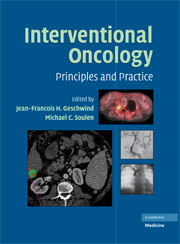Book contents
- Frontmatter
- Contents
- FOREWORD
- ACKNOWLEDGMENTS
- CONTRIBUTORS
- PART I PRINCIPLES OF ONCOLOGY
- PART II PRINCIPLES OF IMAGE-GUIDED THERAPIES
- PART III ORGAN-SPECIFIC CANCERS
- 9 Hepatocellular Carcinoma: Epidemiology, Pathology, Diagnosis and Screening
- 10 Staging Systems for Hepatocellular Carcinoma
- 11 Hepatocellular Carcinoma: Medical Management
- 12 Surgical Management (Resection)
- 13 Liver Transplantation for Hepatocellular Carcinoma
- 14 Image-guided Ablation of Hepatocellular Carcinoma
- 15 Embolization of Liver Tumors: Anatomy
- 16 Transcatheter Arterial Chemoembolization: Technique and Future Potential
- 17 New Concepts in Targeting and Imaging Liver Cancer
- 18 Intrahepatic Cholangiocarcinoma
- 19 Medical Management of Colorectal Liver Metastasis
- 20 Surgical Resection of Hepatic Metastases
- 21 Clinical Management of Patients with Colorectal Liver Metastasis Using Hepatic Arterial Infusion
- 22 Colorectal Metastases: Ablation
- 23 Colorectal Metastases: Chemoembolization
- 24 Radioembolization with 90Yttrium Microspheres for Colorectal Liver Metastases
- 25 Carcinoid and Related Neuroendocrine Tumors
- 26 Interventional Radiology for the Treatment of Liver Metastases from Neuroendocrine Tumors
- 27 Immunoembolization for Melanoma
- 28 Preoperative Portal Vein Embolization
- 29 Cancer of the Extrahepatic Bile Ducts and the Gallbladder: Surgical Management
- 30 Extrahepatic Biliary Cancer: High Dose Rate Brachytherapy and Photodynamic Therapy
- 31 Extrahepatic Biliary Cancer/Biliary Drainage
- 32 Surgical and Medical Treatment
- 33 Percutaneous Renal Ablation
- 34 Embolotherapy in the Management of Renal Cell Carcinoma
- 35 Epidemiology, Diagnosis, Staging and the Medical-Surgical Management of Lung Cancers
- 36 Image-guided Ablation in the Thorax
- 37 Interventional Treatment Methods for Unresectable Lung Tumors
- 38 Interventional Neuroradiology in Head and Neck Oncology
- 39 Percutaneous Ablation of Painful Metastases Involving Bone
- 40 Intra-arterial Therapy for Sarcomas
- 41 Prostate Cryoablation: A Role for the Radiologist in Treating Prostate Cancer?
- PART IV SPECIALIZED INTERVENTIONAL TECHNIQUES IN CANCER CARE
- INDEX
- Plate section
- References
18 - Intrahepatic Cholangiocarcinoma
from PART III - ORGAN-SPECIFIC CANCERS
Published online by Cambridge University Press: 18 May 2010
- Frontmatter
- Contents
- FOREWORD
- ACKNOWLEDGMENTS
- CONTRIBUTORS
- PART I PRINCIPLES OF ONCOLOGY
- PART II PRINCIPLES OF IMAGE-GUIDED THERAPIES
- PART III ORGAN-SPECIFIC CANCERS
- 9 Hepatocellular Carcinoma: Epidemiology, Pathology, Diagnosis and Screening
- 10 Staging Systems for Hepatocellular Carcinoma
- 11 Hepatocellular Carcinoma: Medical Management
- 12 Surgical Management (Resection)
- 13 Liver Transplantation for Hepatocellular Carcinoma
- 14 Image-guided Ablation of Hepatocellular Carcinoma
- 15 Embolization of Liver Tumors: Anatomy
- 16 Transcatheter Arterial Chemoembolization: Technique and Future Potential
- 17 New Concepts in Targeting and Imaging Liver Cancer
- 18 Intrahepatic Cholangiocarcinoma
- 19 Medical Management of Colorectal Liver Metastasis
- 20 Surgical Resection of Hepatic Metastases
- 21 Clinical Management of Patients with Colorectal Liver Metastasis Using Hepatic Arterial Infusion
- 22 Colorectal Metastases: Ablation
- 23 Colorectal Metastases: Chemoembolization
- 24 Radioembolization with 90Yttrium Microspheres for Colorectal Liver Metastases
- 25 Carcinoid and Related Neuroendocrine Tumors
- 26 Interventional Radiology for the Treatment of Liver Metastases from Neuroendocrine Tumors
- 27 Immunoembolization for Melanoma
- 28 Preoperative Portal Vein Embolization
- 29 Cancer of the Extrahepatic Bile Ducts and the Gallbladder: Surgical Management
- 30 Extrahepatic Biliary Cancer: High Dose Rate Brachytherapy and Photodynamic Therapy
- 31 Extrahepatic Biliary Cancer/Biliary Drainage
- 32 Surgical and Medical Treatment
- 33 Percutaneous Renal Ablation
- 34 Embolotherapy in the Management of Renal Cell Carcinoma
- 35 Epidemiology, Diagnosis, Staging and the Medical-Surgical Management of Lung Cancers
- 36 Image-guided Ablation in the Thorax
- 37 Interventional Treatment Methods for Unresectable Lung Tumors
- 38 Interventional Neuroradiology in Head and Neck Oncology
- 39 Percutaneous Ablation of Painful Metastases Involving Bone
- 40 Intra-arterial Therapy for Sarcomas
- 41 Prostate Cryoablation: A Role for the Radiologist in Treating Prostate Cancer?
- PART IV SPECIALIZED INTERVENTIONAL TECHNIQUES IN CANCER CARE
- INDEX
- Plate section
- References
Summary
EPIDEMIOLOGY
Intrahepatic cholangiocarcinoma (ICC) is primary liver cancer with cholangiocytic molecular and histopathologic characteristics located peripheral to the biliary ductal confluence. Cholangiocarcinomas, in general, represent only 15% of primary liver cancers (1), with ICC composing only about 15% of those. These numbers have contributed to the pervasive perception that ICC is a rare cancer, and compared with cancers that globally impact health care (i.e., colon, breast, lung cancers), indeed it is. However, an accelerated increase in incidence has recently been demonstrated, which, coupled with the very poor prognosis imparted by this cancer, has raised concerns. From 1975 to 2000, the age-adjusted incidence of ICC in the United States has increased from 0.32 per 100,000 to 0.85 per 100,000, or roughly an increase from 800 to 2800 newly diagnosed cases per year (2). More concerning is that this 165% increase in age-adjusted incidence (2, 3) is accelerating, with current estimates showing an annual percentage increase in incidence of 9.11% (2). Prognosis is almost universally poor, with little change in demonstrated survival over the past 25 years despite novel and more aggressive treatments. In 1975, the 1- and 5-year survival rates were 15.8% and 2.6% respectively. Twenty-five years later (2000) and despite significant medical advances in cancer treatment 1-, 2- and 5-year survival rates have essentially remained stable, at 25%, 13% and 3.5% respectively (2, 3). Even for the few patients who are initially deemed resectable, post-operative 1-, 3- and 5-year survival is 58%, 33% and 33%, respectively (4, 5).
- Type
- Chapter
- Information
- Interventional OncologyPrinciples and Practice, pp. 213 - 221Publisher: Cambridge University PressPrint publication year: 2008

